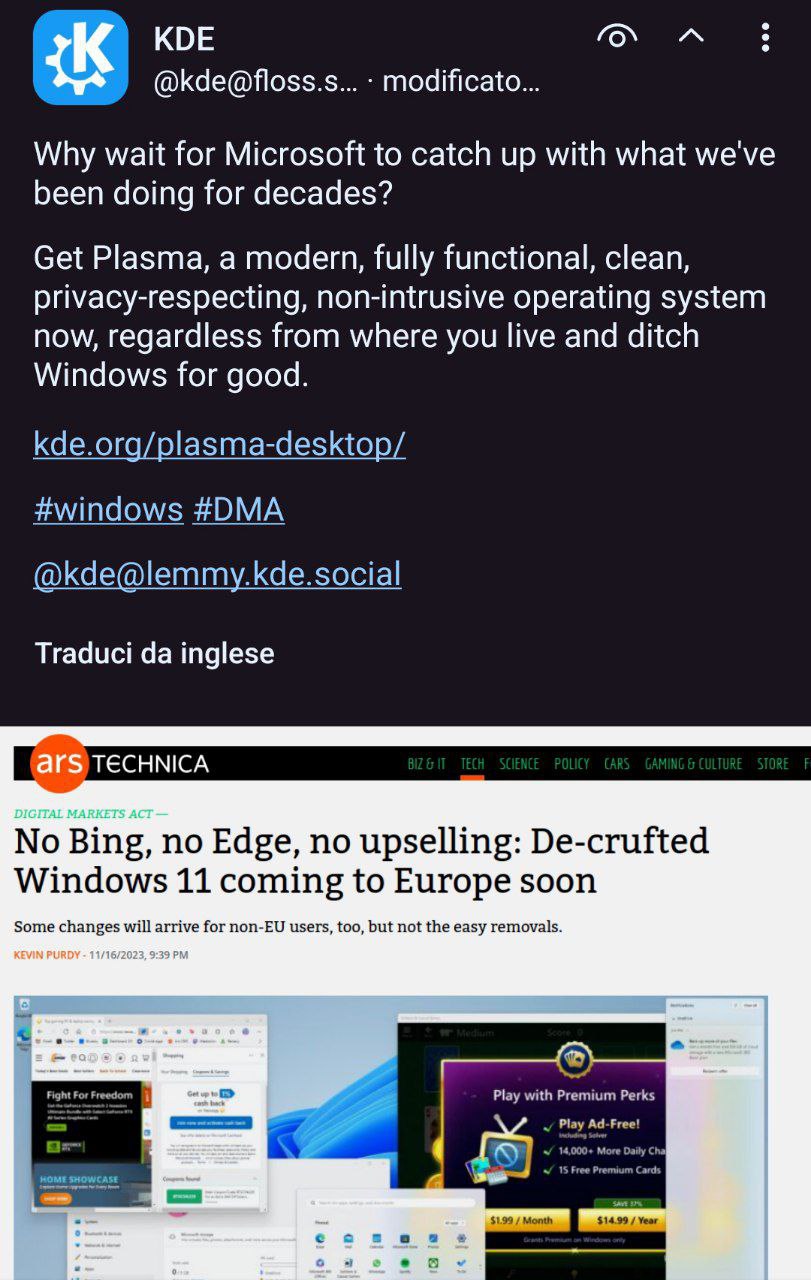Kinda weird that they're calling it an OS, but ig they're just trying to cater to the windows audience
Linux
From Wikipedia, the free encyclopedia
Linux is a family of open source Unix-like operating systems based on the Linux kernel, an operating system kernel first released on September 17, 1991 by Linus Torvalds. Linux is typically packaged in a Linux distribution (or distro for short).
Distributions include the Linux kernel and supporting system software and libraries, many of which are provided by the GNU Project. Many Linux distributions use the word "Linux" in their name, but the Free Software Foundation uses the name GNU/Linux to emphasize the importance of GNU software, causing some controversy.
Rules
- Posts must be relevant to operating systems running the Linux kernel. GNU/Linux or otherwise.
- No misinformation
- No NSFW content
- No hate speech, bigotry, etc
Related Communities
Community icon by Alpár-Etele Méder, licensed under CC BY 3.0
KDE neon is what they're selling
Selling as in advertising, I might add. Neon is free
"But can Linux install things via a single .exe file? HAHAH EAT IT NERD!"
- 10'ish years ago past me, before discovering the magical wonders of the package manager
I found since people are used to app stores, I've had a much easier time convincing people to try out Linux. My mom even said that she always wished her windows PC had a proper app store.
With app images it's easier than installing. Although the chmod step will deter the typical windows user
Windows 11 takes your money, gives you ads, sells your information and ignores your bug reports and feature requests
KDE is free, ad-free and open to contribution
I think we have a clear winner here
But can it run proprietary software used in the industry? From Excel to Photoshop, if you are in a collaborative professional environment, you can't run away from those, and don't tell me you can use the alternatives in Linux, because no, you can't. This is not linux fault, but it's still an issue you can't handwave.
I love linux, but you can't expect people to adopt it just because it's objectively better than windows.
Linux is the modern OS and windows is just a bunch of old shitty technology in a trench suit.
This is kinda how I feel about Windows these days. It's interface, directory structure, shudder the registry, user specific apps (from MS Store or Winget), buttons being inserted into the menu bars on some apps, but not others, button sizes being different sizes, some parts still using the Metro interface. The whole thing either needs a re-write, or should be dropped and something new to replace it. Don't even get me started on things like the eventvwr hanging for 20 seconds after it opens, event tracer API, their in-house abandonment of powershell modules once powershell was open sourced, Windows containers being a disaster, etc.
The problem is that so much critical infrastructure around the world relies on ancient Windows software. I’m pretty sure their backwards compatibility is one of the reasons there’s so much inconsistency in Windows, and every iteration seems to just add more bloat on top.
So basically ever since I first tried Windows 7 I held it as the "Gold standard" for desktop OS's. Half my tweaks to Windows 10 were trying to get it as close to Win7 as I possibly could.
When I finally start experimenting with Linux early this year KDE quickly got me to reconsider my "Gold standard" and finally switch my main machine fully to Linux.
No regrets and certainly ain't switching back even if Microsoft gave me updated Windows 7 with every extra feature I wanted back then.
I've been a Linux user for a decade and a half now, but still use Windows on my corporate laptops. Honestly, it's baffling how Microsoft seem to consistently manage to miss the mark with the UI design. There's lots to be said about the underlying internals of Windows vs Linux, performance, kernel design etc., but even at the shallow, end user, "is this thing pleasant to use" stakes, they just never manage to get it right.
Windows 7 was...fine. It was largely inoffensive from a shell point of view, although things about how config and settings were handled were still pretty screwy. But Windows 8 was an absolutely insane approach to UI design, Windows 10 spent an awful lot of energy just trying to de-awful it without throwing the whole thing out, and Windows 11 is missing basic UI features that even Windows 7 had.
When you look at their main commercial competition (Mac and Chromebook) or the big names in Linux (GNOME, KDE, plenty of others besides), they stand out as a company that simply can't get it right, despite having more resources to throw at it than the rest of them put together.
To me it's absurd how Microsoft gets beaten by a free desktop environment when windows is like their main product. They have billions of dollars. How do they manage to not do better?
Plasma is not a system, but I see how they didnt want to confuse people here
Microsoft will probably never truly catch up with KDE
In the newest windows, it is even possible to hover the volume icon and change it with the mouse wheel!!!
Does clicking on it open the mixer, or still the useless menu which should be accessible with a right click instead?
KDE had that pretty much since the invention of the mouse wheel.
To be fair, forcing a bunch of software on the machine users own was never a good move, and in my opinion, not a new normal.
It's not my primary driver, but I would gladly choose KDE over Windows.
not a kde user but huge respect to them
I came back to KDE after a long absence because I never liked it back in the day (I found it ugly and bloated). I was really surprised by how good it has become. It's now my favourite desktop environment on Linux, and I'm looking forward to version 6. So to any other oldies still avoiding KDE because of how it used to be, it's worth another look.
Fully based
Konquered

What's plasma ? Is it a browser? Sorry, I dont understand computers
Unlike Windows and MacOS, the Linux ecosystem is a lot more modular. For example, graphical user interfaces. There are a few types, ranging from ruthlessly simple tiling window managers to more complex desktop environments that more closely resemble the Windows or MacOS experience.
Linux users may take their pick between about a dozen desktop environments (DEs), including Gnome, Cinnamon, Mate, xfce and LXQT.
KDE (once standing for Kool Desktop Environment, now merely KDE) is a community/organization that produces open source software. They made Krita, a raster art program, KDENLIVE, a video editor, and many other such utilities. They also make the Plasma desktop environment, which is often referred to simply as "KDE" by distro maintainers. For example, you might download Fedora GNOME or Fedora KDE.
KDE Neon is an operating system maintained by KDE which features the Plasma desktop.
What's the current reliable KDE Distro? I've been rolling with Kububtu for a while now, but Ubuntu's Snap mandate has been getting annoying.
I have been enjoying OpenSUSE Tumbleweed. It's a rolling distro unlike the Ubuntu and Debian derivatives, but the updates hardly ever cause problems and it's very easy to roll them back if they do. It also gives you a choice between X11 and Wayland, and Wayland is working well for me on Intel graphics.
KDE nerds: Is there a way to get a normal app launch indicator (cursor with a loading icon/hourglass) instead of either nothing or the little hopping icons that don't animate right?
And you can't get de-crufted Win11 outside Europe! Another win for Plasma!
